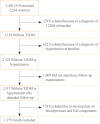Utility of the Visceral Adiposity Index and Hypertriglyceridemic Waist Phenotype for Predicting Incident Hypertension
- PMID: 28537054
- PMCID: PMC5503867
- DOI: 10.3803/EnM.2017.32.2.221
Utility of the Visceral Adiposity Index and Hypertriglyceridemic Waist Phenotype for Predicting Incident Hypertension
Abstract
Background: The aim of this study was to assess the utility of the visceral adiposity index (VAI) and the hypertriglyceridemic waist (HTGW) phenotype as possible hypertension (HTN) predictors in a high-risk population without diabetes and HTN.
Methods: Incident HTN over a 7-year follow-up was assessed among 1,375 first-degree non-diabetic and non-hypertensive relatives of consecutive patients with type 2 diabetes who were 30 to 70 years of age. HTN was defined as a blood pressure reading ≥140/90 mm Hg or the use of antihypertensive medications. We examined the incidence of HTN across VAI quintiles and four groups defined according to baseline fasting serum triglyceride (TG) levels and waist circumference (WC).
Results: The VAI and the HTGW phenotype at baseline were related to an increased risk for HTN. In comparison with the lowest VAI quintile, the highest VAI quintile showed a significant associated with HTN in an age- and gender-adjusted model (odds ratio [OR], 1.65; 95% confidence interval [CI], 1.07 to 2.55). Those with HTGW were 2.3 times (OR, 2.27; 95% CI, 1.54 to 3.35) more likely to develop HTN than those with a normal WC and normal TG levels.
Conclusion: Greater VAI values weakly predicted HTN, whereas the HTGW phenotype was a stronger predictor of incident HTN in an Iranian high-risk population.
Keywords: Hypertension; Hypertriglyceridemic waist; Incidence; Risk factors; Visceral adiposity index.
Copyright © 2017 Korean Endocrine Society
Conflict of interest statement
No potential conflict of interest relevant to this article was reported.
Figures
Comment in
-
Letter: Utility of the Visceral Adiposity Index and Hypertriglyceridemic Waist Phenotype for Predicting Incident Hypertension (Endocrinol Metab 2017;32:221-9, Mohsen Janghorbani et al.).Endocrinol Metab (Seoul). 2017 Sep;32(3):396-397. doi: 10.3803/EnM.2017.32.3.396. Endocrinol Metab (Seoul). 2017. PMID: 28956371 Free PMC article. No abstract available.
References
-
- Poulter NR, Prabhakaran D, Caulfield M. Hypertension. Lancet. 2015;386:801–812. - PubMed
-
- Esteghamati A, Meysamie A, Khalilzadeh O, Rashidi A, Haghazali M, Asgari F, et al. Third national Surveillance of Risk Factors of Non-Communicable Diseases (SuRFNCD-2007) in Iran: methods and results on prevalence of diabetes, hypertension, obesity, central obesity, and dyslipidemia. BMC Public Health. 2009;9:167. - PMC - PubMed
-
- Gillum RF, Mussolino ME, Madans JH. Body fat distribution and hypertension incidence in women and men. The NHANES I Epidemiologic Follow-up Study. Int J Obes Relat Metab Disord. 1998;22:127–134. - PubMed
-
- Harris MM, Stevens J, Thomas N, Schreiner P, Folsom AR. Associations of fat distribution and obesity with hypertension in a bi-ethnic population: the ARIC study. Atherosclerosis Risk in Communities Study. Obes Res. 2000;8:516–524. - PubMed
-
- Folsom AR, Prineas RJ, Kaye SA, Munger RG. Incidence of hypertension and stroke in relation to body fat distribution and other risk factors in older women. Stroke. 1990;21:701–706. - PubMed
LinkOut - more resources
Full Text Sources
Other Literature Sources
Miscellaneous


